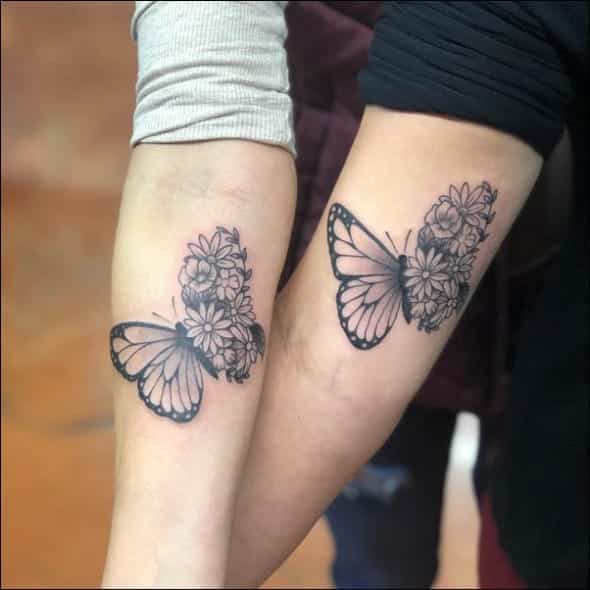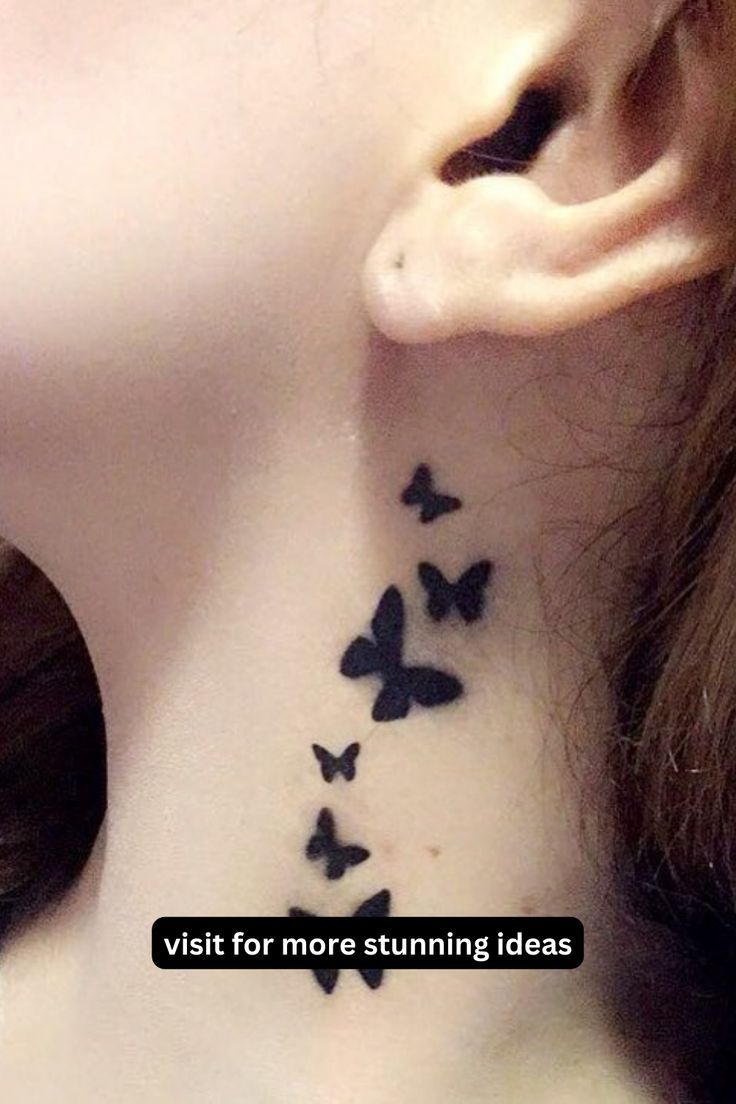In the world of body art, butterfly tattoos have long been a popular choice, symbolizing transformation, beauty, and freedom. The intricate designs and vibrant colors of butterfly tattoos have captivated tattoo enthusiasts and artists alike. This article delves into the art of butterfly tattoos, exploring their cultural significance, design variations, and the impact they have on personal expression.
The Allure of Butterfly Tattoos: A Symbol of Transformation and Grace

The butterfly, with its metamorphosis from a caterpillar to a graceful winged creature, has inspired numerous cultures and spiritual beliefs. This transformation process resonates deeply with individuals seeking to express their own personal journeys of growth and change. Butterfly tattoos serve as a visual reminder of this powerful symbolism, often chosen by those who have overcome challenges or are embarking on new chapters in their lives.
In various cultures, butterflies hold different meanings. For instance, in ancient Greek mythology, butterflies were associated with the soul, symbolizing the transition between life and death. In Native American culture, the butterfly represents change and joy, often serving as a guide during spiritual journeys. Meanwhile, in Chinese culture, butterflies are a symbol of love and happiness, frequently depicted in pairs to represent a long-lasting and harmonious relationship.
Cultural Significance and Personal Interpretations
The cultural significance of butterflies varies across the globe, offering a rich tapestry of meanings that individuals can draw upon when choosing a butterfly tattoo. Some may opt for a traditional design, honoring their cultural heritage, while others may blend elements from different cultures to create a unique, personalized symbol.
For many, the butterfly tattoo serves as a deeply personal emblem, representing a specific event or period of growth. It might commemorate a significant life change, such as a recovery from illness, a new beginning after a difficult situation, or the celebration of a personal achievement. The choice of colors, size, and placement of the tattoo can further enhance its personal significance.
Design Variations and Artistic Interpretations
The beauty of butterfly tattoos lies in their versatility and the endless possibilities for artistic expression. Tattoo artists can draw upon various styles, from the intricate details of realism to the bold lines of tribal designs, to create stunning butterfly tattoos.
Realistic butterfly tattoos showcase the intricate beauty of nature, capturing the delicate wings and vibrant colors of different butterfly species. These tattoos often require a high level of skill and precision, as the artist must carefully replicate the unique patterns and textures of the butterfly's wings. On the other hand, tribal butterfly tattoos draw upon ancient tribal art, using bold lines and geometric shapes to create a powerful and distinctive design.
Other popular styles include watercolor tattoos, which use vibrant colors and fluid lines to create a unique, painterly effect, and minimalist tattoos, which focus on simplicity and often emphasize the graceful lines of the butterfly's wings.
| Tattoo Style | Description |
|---|---|
| Realistic | Intricate and detailed, capturing the natural beauty of butterflies. |
| Tribal | Bold and geometric, drawing upon ancient tribal art. |
| Watercolor | Vibrant and fluid, resembling a watercolor painting. |
| Minimalist | Simple and elegant, emphasizing the grace of the butterfly's form. |

Popular Placement and Size Considerations
The placement of a butterfly tattoo can greatly impact its visual appeal and personal meaning. Some popular choices include the shoulder, upper back, or hip, where the tattoo can be displayed proudly yet covered when desired. Smaller butterfly tattoos are often chosen for more discreet placements, such as behind the ear or on the wrist.
The size of the tattoo is also a crucial consideration. Larger tattoos can accommodate more intricate details and may be preferred by those seeking a bold statement. On the other hand, smaller tattoos can be more subtle and delicate, perfect for those who want a subtle reminder of their personal journey.
The Artistry and Skill Behind Butterfly Tattoos

Creating a stunning butterfly tattoo requires a high level of artistic skill and precision. Tattoo artists must not only understand the anatomy of butterflies and the intricacies of different styles but also be adept at working with various skin tones and textures to ensure the tattoo looks its best.
The process of designing a butterfly tattoo often involves a collaboration between the artist and the client. The artist will consider the client's preferences, the desired style, and the meaning behind the tattoo to create a unique design. This may involve several consultation sessions and sketch revisions to ensure the final design captures the client's vision.
The Role of Color and Shading
Color plays a vital role in butterfly tattoos, enhancing their visual appeal and emotional impact. Vibrant colors can add a sense of energy and joy, while more subdued tones can create a feeling of serenity and reflection. The use of shading techniques, such as shading with dots or lines, can add depth and dimension to the tattoo, bringing the butterfly to life on the skin.
The Importance of Skin Tone and Texture
Every person’s skin is unique, with its own tone and texture. A skilled tattoo artist will take these factors into consideration when creating a butterfly tattoo. Different skin tones can affect the visibility and vibrancy of colors, and the texture of the skin can impact the flow and smoothness of lines. A talented artist will adjust their technique and color choices to ensure the tattoo looks its best on each individual’s skin.
The Healing Process and Aftercare
Once the tattoo is complete, proper aftercare is essential to ensure the tattoo heals well and maintains its vibrant appearance. This includes keeping the tattoo clean, applying moisturizing creams or ointments as recommended by the artist, and avoiding direct sunlight or tanning beds. Following these steps can help reduce scarring and fading, ensuring the tattoo remains a beautiful work of art for years to come.
Butterfly Tattoos: A Timeless Symbol of Beauty and Transformation
Butterfly tattoos continue to captivate and inspire, offering a timeless symbol of beauty, transformation, and personal growth. From their cultural significance to the endless possibilities for artistic expression, butterfly tattoos allow individuals to wear their stories and beliefs on their skin, creating a unique and powerful form of self-expression.
Whether it's a vibrant, life-like representation or a simple, elegant design, a butterfly tattoo serves as a reminder of the beauty of change and the resilience of the human spirit. It is a testament to the power of art to capture and celebrate our unique journeys, making it a popular and enduring choice in the world of body art.
What does a butterfly tattoo symbolize?
+
A butterfly tattoo often symbolizes transformation, change, and personal growth. It can represent overcoming challenges or celebrating new beginnings. In different cultures, butterflies may also symbolize love, joy, or the soul’s journey.
What are some popular styles for butterfly tattoos?
+
Popular styles include realistic tattoos that capture the intricate beauty of butterflies, tribal designs with bold lines, watercolor tattoos with vibrant colors, and minimalist tattoos emphasizing simplicity and grace.
How should I choose the placement and size of my butterfly tattoo?
+
The placement and size of your butterfly tattoo depend on your personal preferences and the meaning you want to convey. Larger tattoos can accommodate more detail and make a bolder statement, while smaller tattoos are more discreet. Popular placements include the shoulder, upper back, hip, wrist, and behind the ear.
What should I consider when choosing a tattoo artist for my butterfly tattoo?
+
When choosing a tattoo artist, consider their portfolio and specialization in butterfly tattoos. Look for artists who understand the symbolism and can bring your vision to life. Ensure they have experience working with different skin tones and textures, as this will impact the final result. Schedule a consultation to discuss your ideas and see if you feel comfortable with their approach and style.
How can I care for my butterfly tattoo after it’s done?
+
Proper aftercare is essential for the healing and longevity of your tattoo. Keep the tattoo clean and moisturized, and avoid direct sunlight or tanning beds. Follow your tattoo artist’s specific aftercare instructions, which may include using certain creams or ointments. Protect your tattoo from the sun with clothing or sunscreen to prevent fading and discoloration.